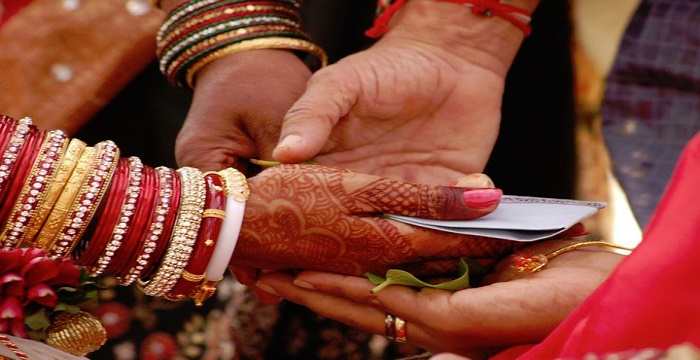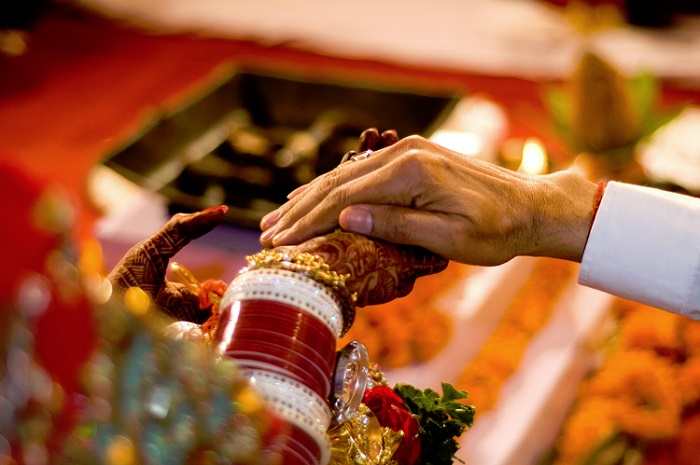
Image Credit: https://kanyadaan.files.wordpress.com/2010/03/manas_kanyadaan.jpg
Indian Hindu weddings comprise of a host of significant rituals that carry deep sentimental significance. Each of the Hindu wedding rituals has an underlying significance that has been passed down through generations since the time of the Vedas. Some of these rituals have been modified along the way, having evolved into something that is completely new. The modern Hindu wedding rituals are a mishmash of such customs and traditions, and a celebration like no other.
Kanyadaan is one such indispensible ritual during a Hindu wedding. The literal translation of the term comes down to the meaning of the two comprising words - Kanya=Maiden and Daan=Donation, which may be seen as the Donation of a Maiden. It is an age old tradition where the bride’s father presents his daughter to the groom, entrusting him with her future wellbeing. No man is ever going to be good enough for his little girl and yet he is willing to entrust his most precious person, to a relative stranger, hoping that he cares for her with the same levels of love and patience as he does. It is an emotional and sentiment-laden ritual which recognizes the sacrifices a father makes in order to ensure her daughters happiness.
History & Evolution
Kanyadaan is a relatively new concept when it comes to wedding rituals. The Vedas, which are texts that delineated principles of living one’s life through daily life in order to attain eternal freedom, did not have this concept. During the Vedic times, consent of the women for marriage was given utmost importance. She had the final say about whom she wanted to marry. She entered into the union as the groom’s equal, the other half to his existence. The concept of the father offering his daughter to the groom was unheard of. As time went by, the principles of Vedas evolved giving rise to the Manu Smriti texts that emerged as the foundation for modern Indian Hindu laws and jurisprudence. It outlines the tenets of Brahmanical dharma, covering each and every aspect of an ideal Brahmin life, elaborating the do’s and don’ts. After Hinduism evolved from Vedic traditions to accepting the treatise of Manus as the basis, the position of women changed in the Hindu society. The status of equality that women enjoyed during Vedic times was vastly curtailed, and they were stripped of any independence. They were placed under lifelong male guardianship – Father when unmarried, Husband when married and finally son when old and widowed. From here emerged the concept of Kanyadaan, which some would just consider transfer of property rights, the property being the girl to be wedded. According to Manu Smriti, Kanyadaan is the biggest achievement for any family man, the greatest ‘daan’ or gift of all. But, in real context, the scenario is not as cut and dried as that. The ritual is enmeshed with a lot of emotions that undermine the religious side of the process. It exemplifies the bond between a father and a daughter and their mutual love.

Rituals
The Kanyadaan ceremony marks the biggest transition in a bride’s life. The ceremony confirms the change of role in her life, from a daughter to a wife. From relative security of her father’s house she now embarks on an unknown journey to a new place and new surroundings.
Like all other Hindu traditions, fasting is mandatory for the individuals performing this ritual. It can be the bride’s father, or may be some other elder male member of the family. Traditionally speaking, he is not to take any food or water before he has performed the ritual, but in most communities, water is allowed nowadays.
After the bride has been called into the wedding arena, and has exchanged garlands with the groom during the Varmala ceremony. She is then seated on the opposite side of the groom in front of the holy fire. Then groom extends his right hand upon which the bride’s right hand is placed. This ritual is known as Hastamilap or Joining of the Hands. Their hands are then joined by sacred thread, or a piece of red cloth, betel leaves, betel nuts, and flowers are placed on top. Some customs also include money and a gold coin in this ceremony. The bride’s father or in some cases both the parents place their hand on top and sometimes pour Ganga Jal or a mix of Ganga Jal and Milk over the joined hands, all the while repeating after the priest chanting verses in praise of Kamadeva, the God of Love.
The groom is then supposed to place his free hand on the bride’s right shoulder, which symbolizes him taking responsibility for her wellbeing. Their fates now linked together, the bride is no longer a part of her father’s household and is accepted into the groom’s family. From this point forward all the rituals that are to be observed are done according to the traditions of the groom’s side.
The groom keeps on holding the bride’s hand and they proceed to take the Pheras (circling of the holy fire together) and uttering of the Saptapadi or the seven customary wedding vows.
Significance
The ritual of Kanyadaan is ripe with deep religious symbolisms. The groom is considered a representation of Lord Vishnu all through the wedding, and during Kanyadaan the parents are offering their daughter, a considerable piece of their existence, for his taking. This is considered to be the greatest offering one can present to the Supreme Being and it is believed that upon Kanyadaan the parents of the bride are absolved of all their earthly sins, and are said to attain moksha, relief from the cycle of birth, death and rebirth.
On the other hand, it is emphasized during the ritual, that the parents are entrusting him with the most precious ‘gift’ in this world. It is expected of him that he will always take care of his wife, their daughter, respect her and keep her happy in every way possible.
The ritual, while it might seem a bit misogynistic at its core, is not just a Hindu custom, but equivalent traditions may be cited in Christian and Jewish weddings where the father of the bride leads her to the wedding altar and ‘gives her away’ to the groom.




